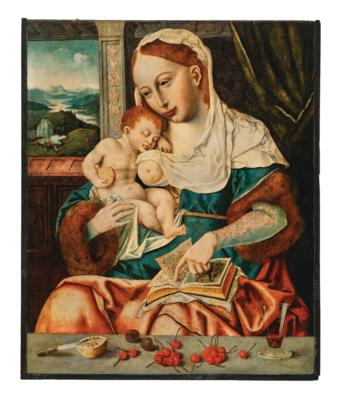Circle of Joos van Cleve
(Cleve circa 1485–1540/41 Antwerp)
The Madonna and Child with a book,
oil on panel, transferred onto canvas, 62.5 x 50 cm, unframed
Provenance:
Private collection, Switzerland
The present painting is one of a series of versions of the same subject, executed by the studio or circle of Joos van Cleve, after that of the master which generated a considerable success among his contemporaries and followers. The best-known version attributed to the master, with contributions by his studio, is datable to 1525 and is preserved in the Metropolitan Museum of Art, New York (see M. W. Ainsworth, K. Chrstiansen, J. Chapuis (eds.), From Van Eyck to Bruegel: Early Netherlandish Painting in The Metropolitan Museum of Art, New York 1999, pp. 360–362). This painting shares exactly the same composition as the present work for the representation of the Madonna and Child but differs in the description of the setting and the surrounding objects.
The present painting presents exactly those qualities for which Dutch painting has always been admired: extraordinary realism, exemplified here, thanks to the artist’s close attention to detail, by the transparency of the glass in the foreground, the fur of the Virgin’s cuffs, the depiction of the paper pages of her book, and the fruit on the shelf before her. These are all elements that perfectly combine in the intimate and affectionate atmosphere of the scene, characteristic to renderings of the Madonna and Child; here the latter is shown asleep in his mother’s lap. The setting, in an elegant room, opens onto a green landscape populated with little figures, through which a river runs to the distant blue mountains, revealing a clear application of Leonardo’s sfumato technique.
This type of representation, with the mother engaged in devotional reading as she holds her sleeping child in her arms, is rich in symbolic references. The sleeping child is to be understood as a prefiguration of the events of the Passion. The apple he holds identifies him as the new Adam while recalling original sin.
Joos van Cleve’s name derives from his birthplace Cleve in the present-day region of the lower Rhine in Germany, close to the Dutch border. His father William van Cleve the Elder was also a painter documented in the Academy of Antwerp. Subsequently Joos van Cleve became the deacon of the guild; his art was influenced by the great masters of the fifteenth century, and notably by Dürer (1471–1528) and Leonardo (1452–1519).
Specialist: Mark MacDonnell
 Mark MacDonnell
Mark MacDonnell
+43 1 515 60 403
old.masters@dorotheum.com
25.10.2023 - 18:00
- Estimate:
-
EUR 30,000.- to EUR 40,000.-
Follow Remove
Circle of Joos van Cleve
(Cleve circa 1485–1540/41 Antwerp)
The Madonna and Child with a book,
oil on panel, transferred onto canvas, 62.5 x 50 cm, unframed
Provenance:
Private collection, Switzerland
The present painting is one of a series of versions of the same subject, executed by the studio or circle of Joos van Cleve, after that of the master which generated a considerable success among his contemporaries and followers. The best-known version attributed to the master, with contributions by his studio, is datable to 1525 and is preserved in the Metropolitan Museum of Art, New York (see M. W. Ainsworth, K. Chrstiansen, J. Chapuis (eds.), From Van Eyck to Bruegel: Early Netherlandish Painting in The Metropolitan Museum of Art, New York 1999, pp. 360–362). This painting shares exactly the same composition as the present work for the representation of the Madonna and Child but differs in the description of the setting and the surrounding objects.
The present painting presents exactly those qualities for which Dutch painting has always been admired: extraordinary realism, exemplified here, thanks to the artist’s close attention to detail, by the transparency of the glass in the foreground, the fur of the Virgin’s cuffs, the depiction of the paper pages of her book, and the fruit on the shelf before her. These are all elements that perfectly combine in the intimate and affectionate atmosphere of the scene, characteristic to renderings of the Madonna and Child; here the latter is shown asleep in his mother’s lap. The setting, in an elegant room, opens onto a green landscape populated with little figures, through which a river runs to the distant blue mountains, revealing a clear application of Leonardo’s sfumato technique.
This type of representation, with the mother engaged in devotional reading as she holds her sleeping child in her arms, is rich in symbolic references. The sleeping child is to be understood as a prefiguration of the events of the Passion. The apple he holds identifies him as the new Adam while recalling original sin.
Joos van Cleve’s name derives from his birthplace Cleve in the present-day region of the lower Rhine in Germany, close to the Dutch border. His father William van Cleve the Elder was also a painter documented in the Academy of Antwerp. Subsequently Joos van Cleve became the deacon of the guild; his art was influenced by the great masters of the fifteenth century, and notably by Dürer (1471–1528) and Leonardo (1452–1519).
Specialist: Mark MacDonnell
 Mark MacDonnell
Mark MacDonnell
+43 1 515 60 403
old.masters@dorotheum.com
|
Buyers hotline
Mon.-Fri.: 10.00am - 5.00pm
old.masters@dorotheum.at +43 1 515 60 403 |
| Auction: | Old Masters |
| Auction type: | Saleroom auction with Live Bidding |
| Date: | 25.10.2023 - 18:00 |
| Location: | Vienna | Palais Dorotheum |
| Exhibition: | 14.10. - 25.10.2023 |

